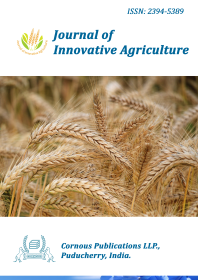
Journal of Innovative Agriculture
Peer Reviewed Open Access Journal
ISSN: 2394-5389 NAAS: 4.05
Submit Manuscript
Peer Reviewed Open Access Journal
ISSN: 2394-5389 NAAS: 4.05
Submit ManuscriptForty-eight lowland rice genotypes with two checks were evaluated for their agronomic performance, genetic variability, heritability, and genetic advance for yield and yield contributing traits. Among the tested genotypes SR33859-HB3324-133 (45.7 qha-1), SR33859-HB3324-93 (40.2 qha-1) were the high yielding genotypes above the better check. The analysis of variance showed significant differences for all measured traits and indicating the presence of high genetic variability among genotypes. A highly significant (P≤0.001) correlations were observed between flag leaf length and plant height (rp= 0.76, rg=0.84), panicle length and plant height (rp= 0.77, rg= 0.90), and panicle length and flag leaf length (rp= 0.75, rg=0.89). The estimates of GCV were lower than the respective PCV for all traits, indicating the influence of environmental factors on the expression of the traits. Characters like grain yield (94 %, 90.9), flag leaf length (97 %, 71.6), number of tillers per hill (91 %, 67.2) and plant height (99.0 %, 50.7) showed high heritability coupled with moderate genetic advance as percent of the mean, which suggesting that these traits are controlled by the additive type of gene action and selection could be possible for the improvement of these characters. On the other hand, moderate heritability estimates with low genetic advance as percent of the mean were recorded for flag leaf width and number of days to maturity indicated the presence of non-additive gene effects, and selection for these traits would be poor. As a result, the variability that exists in the germplasm provides an opportunity to use these genotypes in the genetic improvement program.
rice, variability, GCV, PCV, heritability, genetic advance
Akongo, G. O., Gombya-Ssembajjwe, W., Buyinza, M., & Namaalwa, J. J. (2018). Characterisation of rice production systems in northern agro-ecological zone, Uganda. Journal of Agricultural Science (Toronto), 10(1), 272-282.
Biswaranjan, P., Behera, B., & Jena, D. (2018). Genetic variability, heritability and genetic advance of some prominent advanced lines of upland rice (Oryza sativa L.) broadcast Aus genotypes. International Journal of Current Microbiology and Applied Sciences, 7(8), 1911–1919.
Burton, G. W. (1952). Quantitative inheritance in grasses. Proceedings of the 6th International Grassland Congress, 1, 277–283.
Dogara, A. M., & Jumare, A. I. (2014). Origin, distribution and heading date in cultivated rice. Int J Plant Biol Res, 2(1), 1008
FAO (2014). Food and Agriculture Organization of the United Nations Statistics division.
FAO (2018). Food and Agriculture Organization of the United Nations Statistics division.
Haggblade, S. and Dewina, R. (2010) Staple Food Prices in Uganda. Prepared for the Comesa Policy Seminar on “Variation in Staple Food Prices: Causes, Consequence, and Policy Options”, Maputo, 25-26 January 2010, 1-15.
Haggblade, S., & Dewina, R. (2010). Staple food prices in Uganda (No. 1093-2016-87748).
IRRI (International Rice Research Institute) (2014) Standard Evaluation System for rice (SES). 5th Edition, International Rice Research Institute, Los Banos.
Johnson, H. W., Robinson, H. F., & Comstock, R. E. (1955). Estimates of genetic and environmental variability in soybeans 1. Agronomy journal, 47(7), 314-318.
Kijima, Y. (2012). Expansion of lowland rice production and constraints on a rice Green Revolution: evidence from Uganda. JICA-RI working paper, 49.
Kijima, Y., & Sserunkuuma, D. (2013). The adoption of NERICA rice varieties at the initial stage of the diffusion process in Uganda. African Journal of Agricultural and Resource Economics, 8(311-2016-5610), 46-56.
Nikki Kumari, & Parmar, M. B. (2020). Heritability and genetic advance analysis in rice (Oryza sativa L.) genotypes under aerobic condition. International Journal of Current Microbiology and Applied Sciences, 9(3), 1196–1204.
Payne, R. W., Murray, D. A., Harding, S. A., Baird, D. B., & Soutar, D. M. (2009). GenStat for windows introduction. VSN International, Hemel Hempstead, 204.
Senapati, B. K., & Kumar, A. (2015). Genetic assessment of some phenotypic variants of rice (Oryza spp.) for some quantative characters under the Gangatic plains of West Bengal. African Journal of Biotechnology, 14(3), 187-201.
Seyoum, M., Alamerew, S., & Bantte, K. (2012). Genetic variability, heritability, correlation coefficient and path analysis for yield and yield related traits in upland rice (Oryza sativa L.). Journal of plant sciences, 7(1), 13-22.
Sravan, T., Rangare, N. R., Suresh, B. G., & Kumar, S. R. (2012). Genetic variability and character association in rainfed upland rice (Oryza sativa L.). Journal of Rice Research, 5(1), 2.
Suwansa, S., Chuchert, S., & Chaiwong, S. (2017). Genetic divergence of lowland rice (Oryza sativa L.) genotypes in Thailand. Black Sea Journal of Agriculture, 7(1), 1–7.
